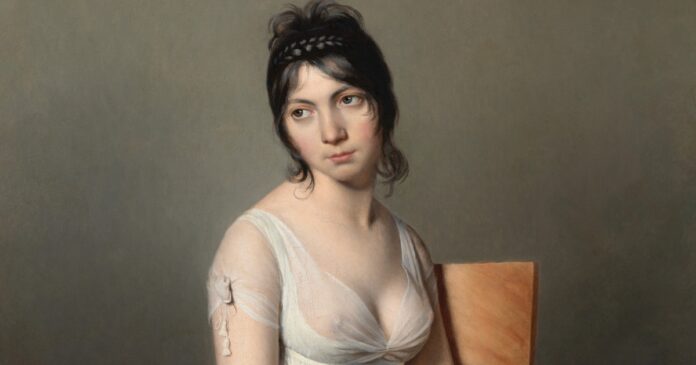They were in mourning, having survived the Reign of Terror. Many of their loved ones had lost their heads, literally — and grotesquely. Yet they responded with eros: with celebrations, parties, a cult of perfectly logical perversity. One ball restricted its guest list to the adult offspring of the guillotined. Mocking the executioners’ zeal for decapitations, these beautiful young survivors greeted each other by violently shaking their heads.
The women among them cast off corsets and donned tunics so sheer at times that they were described as “woven air.” Sometimes their dresses were worn slightly damp, mimicking the “wet drapery” look of ancient Greek and Roman sculpture.
The women were known as the merveilleuses, or “marvelous ones.” This painting in the National Gallery of Art, “Portrait of a Young Woman in White,” depicts one of them. It’s by an unknown French painter thought to have been in the circle of Jacques-Louis David. With their dandyish male counterparts, known as the incroyables (or “incredibles”), the merveilleuses were part of an aristocratic subculture in France at the end of the 18th century.
Their reaction to having survived the Reign of Terror was to embrace decadence, silliness and brazen eroticism. They attended balls, dressed in outrageous fashions and thumbed their noses at the psychotic murderers who had carried out the Terror. Their basic attitude was that Robespierre, who orchestrated the demented campaign that ended with his death by guillotine in 1794, could burn in hell.
But why, for all the formality and clarity of her rendering, does this young woman seem swaddled in a fog of ennui? Why does she almost burn with contempt?
The historical backdrop may get us some of the way, but there is something ineffable and supremely unreachable about this woman — a deeper psychological inaccessibility that magnetizes feeling, kindling dark laughter, stirring insurrectionary thoughts.
To modern eyes, French neoclassicism can seem stifling in its formality. But this painting may be a portal to other ways of looking at neoclassicism from the revolutionary era. What if that formality had an ironic edge? What if its stiffness, emanating sobriety and social status, were, in the hands of young people, a kind of burlesque, an inversion?
These privileged youths were responding, after all, to a society-wide trauma, an almost unimaginable upheaval, that had specifically targeted their kind. Jammed into an impossible predicament, they developed their own colloquialisms, fashions, hairstyles and macabre greetings.
I can imagine one of them looking at this portrait, soaking in its sexy registration of death, its complicated contempt, and hurrying on to the ball to seek out its damned elusive subject, here, there, everywhere.



